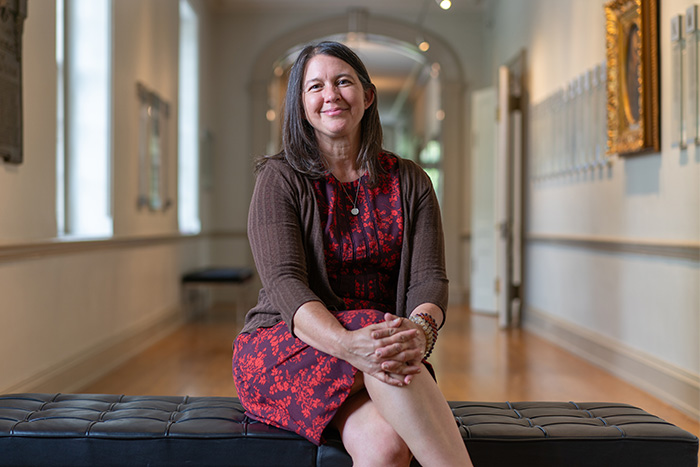10 Questions With Renée Ann Cramer

Photo by Dan Loh.
On July 1, Renée Ann Cramer joined Dickinson as our new provost and dean of the college. During the first whirlwind weeks of the fall semester, we chatted about her background, first impressions and plans.
By MaryAlice Bitts-Jackson
For readers who don’t work in academia, how would you briefly explain your dual role?
I lead the faculty and academic-affairs staff, creating opportunities for leadership and innovation, and work closely with fellow members of President Jones’ leadership team. I also represent Dickinson to alumni, board members and external constituents.
What excites you the most?
I believe wholeheartedly in a liberal-arts education for the benefit of a larger good. And Dickinson is a place where people clearly care about each other and want to engage in all of what it means to be a scholarly community. Our students are articulate, engaged and focused, and our faculty and staff are world class and devoted to students’ development. So we’re coming from a position of strength. I’m really excited by the interdisciplinary pedagogical innovation I see here.
What do you see as the biggest challenge in higher ed?
People often say “enrollment and the demographic cliff” when asked this question, based primarily on studies authored by Nathan Grawe. I think many misunderstand what Grawe is actually saying. He’s saying we're facing demographic challenges because the number of people we consider to be college-going, and the people who consider themselves to be college-going, is declining. This gives us the chance to reconceive of what it means to be someone who goes to college, like nontraditional students, transfer students and degree completers. I’m curious about what this observation means in the Dickinson setting.
What are some additional challenges we see at Dickinson?
Access, affordability and public perception. We’re also challenged with translating what we're already doing. We know a liberal-arts education empowers students to be competitive in a quickly changing world. We have to say that in ways that speak to contemporary students and their families.
Speaking of challenges: You were the only one of your siblings to attend college and one of few in your graduating class who left your small hometown in South Dakota, right?
Yes. Growing up where I did, I wasn’t prepared for college in the way that students in school districts with means were. We had no AP program. I placed out of classes and made my own curriculum; one year, I read all the Russian masters on my own. I showed up at Bard College, and everyone in the room knew how to pronounce the names in Plato.
Given that background, how and why did you decide to go to college?
I always wanted to go to college. My question was: How do I justify the expense and the move to my family and peers? I didn’t know, then, that college is about expanding your intellect and capacities.
Do you think your personal experiences give you a unique perspective on the needs of first-generation students at a liberal-arts college?
I have tremendous empathy for students who come into college thinking they have to choose a preprofessional major, because they don’t see the value of a mind-expanding education. We need to meet these students where they are and then show them the potential and possibilities.
You also bring personal experience to bear in your understanding of the educational challenges that were posed by COVID-19.
Teaching during the lockdown phase of COVID was the most difficult professional thing I’ve done, and parenting during that period was one of the most difficult personal things I’ve done. We must not underestimate the residual effects of these challenges on our students, staff and faculty. We’ve turned the corner, I think, but there are challenges down the road, because students coming in may have missed important social and cognitive milestones. For instance, the data I've seen indicates that the interruption in math education for students in second to fifth grade was really significant. We won’t see those effects in higher ed for a few years, but we’re looking ahead.
We’re speaking a few weeks into the fall semester. What are your goals for your first 90 days?
They’re related to communication, relationships and vision. Communication: I release The Dispatch [all-campus newsletter] every three weeks and share updates at monthly faculty meetings. Relationships: By the end of this academic year, I plan to have had a sustained conversation with 100% of the faculty who aren't on sabbatical or leave. I’m also building relationships with senior staff. Vision: I hope to ask good questions, make astute observations and begin to think out loud with faculty and staff about places we could fruitfully innovate in the academic program, in leadership and governance and in our imagination of the future.
How’s it going so far?
This is the most fun job I've ever had! It uses every skill I've developed and gives me the opportunity to keep growing. I really enjoy the challenge, and I enjoy doing meaningful work on behalf of the college.
Read more from the fall 2023 issue of Dickinson Magazine.
TAKE THE NEXT STEPS
Published November 21, 2023